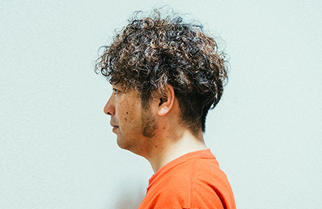
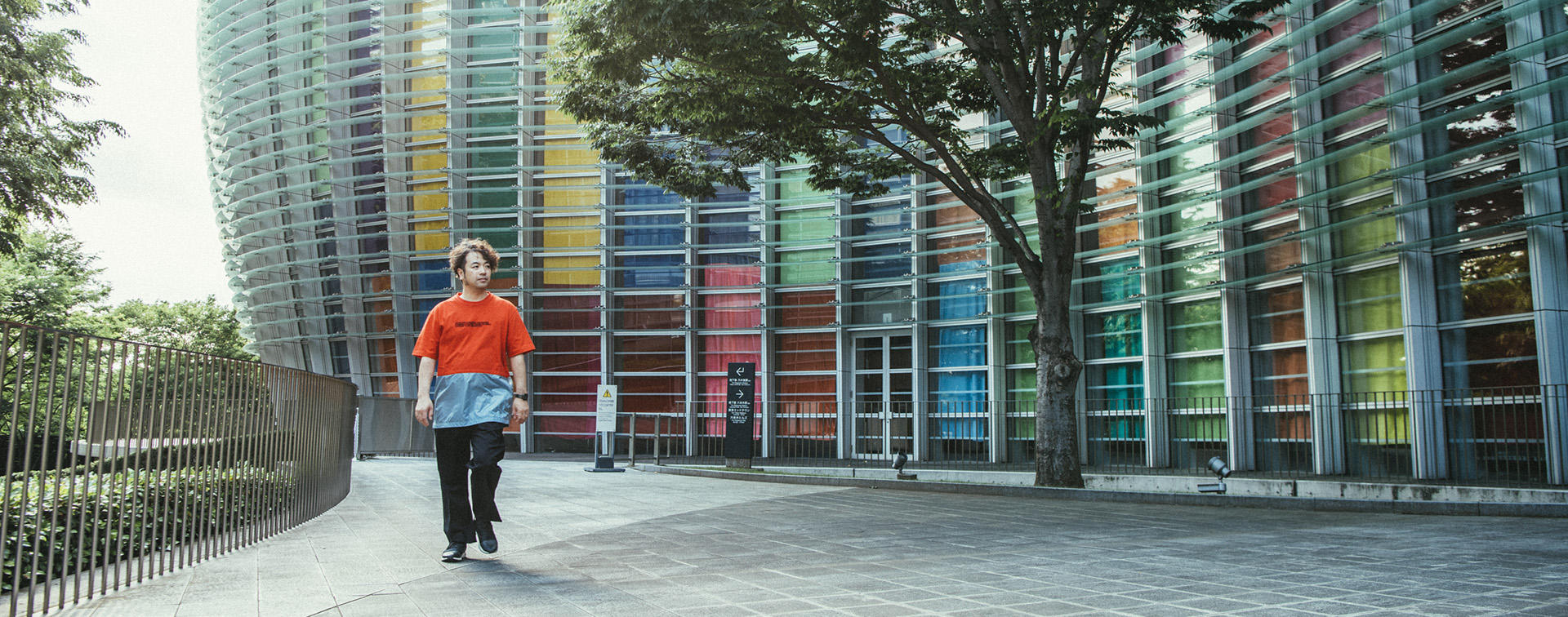
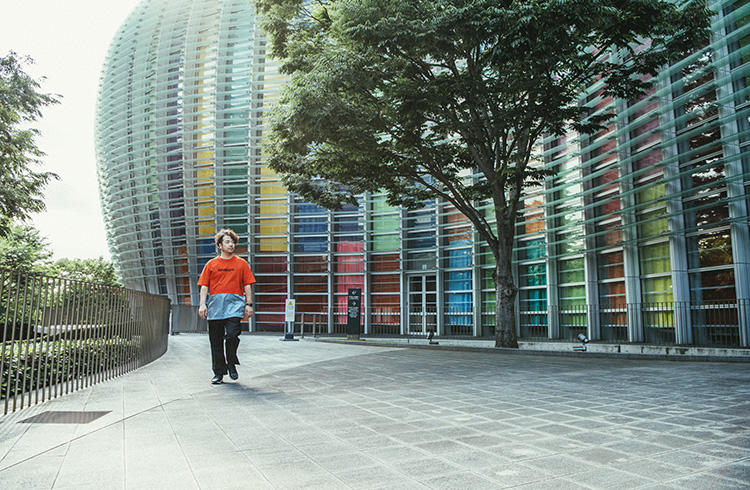
Art is about being suspicious of what people say
Exclusive workshops held by artists and curators for the general public In Roppongi
Contemporary artist Kengo Kito has released a wide range of paintings, installations and three-dimensional art both at home and abroad. At Roppongi Art Night 2018, which was held May 26-27, Kito showed works that expressed fleeting and fantastical dreams. Aside from Roppongi Art Night, Kito has participated twice in exhibitions held in Roppongi. He told us about his perspectives as an artist on the current state of Roppongi and art, and the possibilities they have.
Deeper learning of art through small-group dialogues
We live in times where digital technology and handcraft can be linked with art. Art will probably increasingly expand in the future, and I think that is interesting. In Europe, the word "art" essentially means "skills" and not "beauty", but in Japan, there is the tradition of seeking beauty in art. Skills can be taught at school, but beauty cannot be taught. In order to delve further into art, perhaps it might be a good idea to hold private workshops or lectures in Roppongi, bringing together artists, curators and art viewers. Opportunities could be provided for artists and curators to talk at length to art viewers on a one-to-one basis or a one-to-two basis; they could begin by answering the question of "What is art?" and go on to explain about the people who sell art, who buy art and the process of buying an expensive piece of artwork. Nowadays, many talk events and workshops are held which are targeted for fairly large groups of attendees, but I feel that by offering events for large numbers, there are people who actually lose interest in attending. I think that events for small groups will enable people to experience art from a different angle in a deeper way.
The day when the streets of Roppongi became empty
I think Roppongi is a compact place. It is dotted all over with art museums, art galleries and cultural facilities that are representative of Tokyo: the Mori Art Museum, the National Art Center, Tokyo, Suntory Museum of Art, 21_21 DESIGH SIGHT, Taka Ishii Gallery and Tomio Koyama Gallery. There are also commercial facilities like Tokyo Midtown and Roppongi Hills; you can visit each one of these buildings while taking a walk, and I find the scale of the place attractive.
I think the first time I came to Roppongi was in 2003 when the Mori Art Museum opened and I went to its exhibition. Later, my ties with Roppongi were born when I participated as an artist in the "Roppongi Crossing 2007: Future Beats in Japanese Contemporary Art" exhibition at the Mori Art Museum and the "Artist File 2011: NACT Annual Show of Contemporary Art" at the National Art Center, Tokyo.
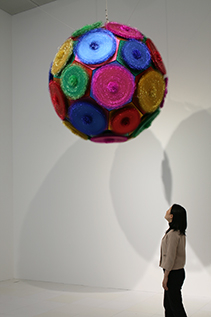
"Roppongi Crossing 2007: Future Beats in Japanese Contemporary Art" exhibition
In 2004, Mori Art Museum began holding its series of "Roppongi Crossing" exhibitions focusing on the current trends in contemporary art. In 2007, the second such exhibition dubbed "Roppongi Crossing 2007:Future Beats in Japanese Contemporary Art", was curated by four people: art critic Kazuo Amano, Natsumi Araki, curator at Mori Art Museum, Naoki Sato, art director at Asyl, and art critic Noi Sawaragi. The four curators held extensive talks and picked 36 artists for their creative potential.
Period: Oct. 13 (Sat) 2007 - Jan. 14 (Mon. national holiday) 2008
Venue: Mori Art Museum
Kengo Kito "Royal (Polyhedron)" 2007
Photo of exhibition: "Roppongi Crossing 2007: Future Beats in Japanese Contemporary Art" Mori Art Museum 2007
Courtesy of Gallery Koyanagi and Kenji Taki Gallery
Photography: Keizo Kioku
I clearly remember the day when I transported my work for the "Artist File 2011: NACT Annual Show of Contemporary Art" exhibition. I went out to do shopping for the transport, and an earthquake occurred when I was on the underground railway platform. It was the Great East Japan Earthquake of March 11, 2011. The ground shook so hard that it was almost impossible to keep standing, and the people around me were in a panic. But I had to transport my work, and I stayed at the museum. The people in the streets gradually disappeared, and before I knew it, there was no one.
The streets of Roppongi became devoid of people. It was a sight I had never even imagined. It was an extraordinary sight in the midst of the everyday. It was almost like an illusion, or a dream, but what happened that day was real. Of course, the opening of the exhibition was postponed, and I went back to Berlin where I was living at that time. Even now, when I hear the word "Roppongi", I recall the sight of the empty Roppongi streets.
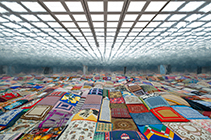
"Artist File 2011: NACT Annual Show of Contemporary Art" exhibition
One of the missions of the National Art Center, Tokyo is to introduce new artistic expressions of living, contemporary artists. The works of noteworthy artists in Japan and abroad are selected by the curatorial staff for the series of exhibitions called the "Artist File: NACT Annual Show of Contemporary Art". The exhibition held in 2011 was the fourth to be held: it introduced the works of eight Japanese and overseas artists in wide range of genres - painting, photography, pottery, movies and installation.
Period: March 19 (Sat) - June 6 (Mon) 2011
*The exhibition was initially scheduled to open March 16 (Wed) but the opening and closing dates were changed due to the Great East Japan Earthquake.
Venue: National Art Center, Tokyo
Kengo Kito "Inconsistent Surface" 2011
Photo of exhibition: "Artist File 2011: NACT Annual Show of Contemporary Art", National Art Center, Tokyo
Photography: Norihiro Ueno

"hanging colors" and "broken flowers" depict a dreaming Roppongi
Talking of illusions and dreams, I participated as one of the main artists at "Roppongi Art Night 2018" whose theme was "The city dreams of art". Roppongi Art Night is a one-night event and that was a premise that I kept in mind as I asked myself what exactly dreams are. In the end, I showed two works - "hanging colors" and "broken flowers" at the National Art Center, Tokyo. With "hanging colors", colorful cloths were put up on the glass façade - each cloth can be hung or taken down in a second so it's a work that is completed by short movements; with "broken flowers", the images disappear without a trace with just one turn of the switch. The ephemeral nature of dreams is thus expressed through the very materials used for the works.
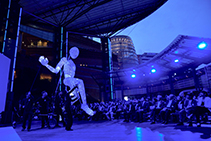
Roppongi Art Night 2018
Roppongi Art Night is a one-night festival of art that started in 2009. The theme of Roppongi Art Night 2018 was "the city dreams of art". Three artists - Teppei Kaneuji, Kengo Kito, and Muneteru Ujino - participated in the event as the main artists, showing various installations and performances in the Roppongi area. The purpose of Roppongi Art Night, held every year, is to propose a new lifestyle of enjoying art in everyday life, and also to be an innovative example of town development in the great metropolis of Tokyo. It continues to evolve as Tokyo's representative art festival.
Period: May 26 (Sat) - 27 (Sun) 2018
Venues: Roppongi Hills, Mori Art Museum, Tokyo Midtown, Suntory Museum of Art, 21_21 DESIGN SIGHT, National Art Center, Tokyo, Roppongi shopping district, facilities and public spaces in Roppongi cooperating with the festival.
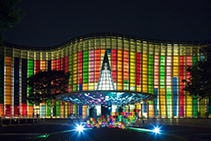
hanging colors, broken flowers
Works by Kengo Kito exhibited at the National Art Center, Tokyo. "hanging colors" evoking a colorful waterfall, was a work of colorful cloths hung all over the glass façade of the art museum which was designed by Kisho Kurokawa. The work accentuated the contours of the façade which normally look subtle. During the daytime, the art museum was filled with dreamy colors as the sunlight passed through the cloths. © Photograph: Shinya Kogure
The initial image I had for "broken flowers" is ghosts. A student of mine at university (Kyoto University of Art and Design) told me about seeing a female ghost. That triggered many questions inside me such as "What exactly are ghosts?" and "Are they copies of humans?" and "If my reflection in the mirror were to materialize, would it have internal organs?" So I made "broken flowers", showing flowers in place of ghosts.
Roppongi Art Night is like a "matsuri" (festival), isn't it? It all ended in a flash, and I was left feeling sort of tired, as if I had been making futile efforts. (laughs). But I realized that feeling that way is the whole point of Roppongi Art Night.
Artwork that change the way one looks at the streets
In interviews, I'm often asked, "How does region and place affect your work?" I think people ask me that a lot partly because of my history. I was born in Nagoya, and I went to Kyoto to go to university, and then I lived in New York and Berlin; I lived for a short while in Tokyo and now I live in Takasaki City, Gunma Prefecture. I think the other reason is that in recent years, we are seeing more art festivals in Japan and abroad which utilize regional resources. But actually, I myself do not usually make works with region or place in mind.
Roppongi Art Night, in which I recently participated, is an art festival that makes use of the locality of Roppongi, but rather than drawing inspiration from the region, my focus is on making works that changes the viewer's awareness and the way the viewer looks at Roppongi.
Of course, I do think it's interesting to have works that have an affinity with a region. But perhaps a city will become more interesting if there were more works that changed people's views of the streets. I personally have more interest in making works that will transform a city.
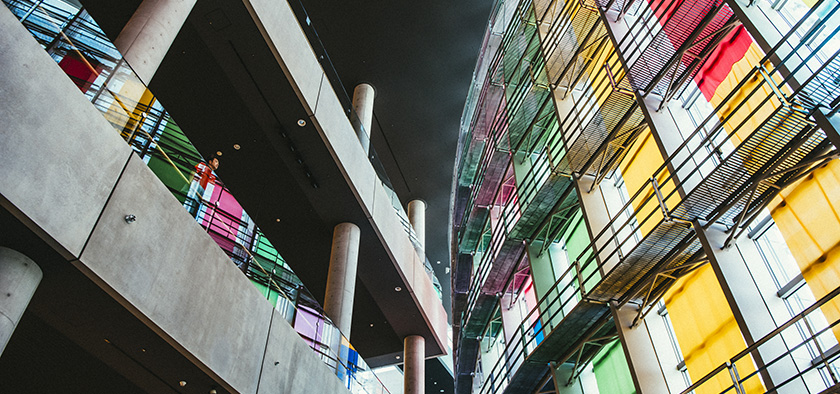
Information makes people conservative
I recently feel that while interest is growing in art, the number of young people aspiring to become artists is declining. Of course, this might be partly due to the overall drop in the number of children, but I still feel that compared to when I was young, there are more people wanting to become designers, and less people wanting to become artists.
I think one reason for this is that information has become so easily accessible due to the advance of the Internet. All that information is seen to be the equivalent of the end result and it makes people anxious. In reality, you can't tell whether the results will really be like that, and yet people are becoming increasingly conservative. You will never become an artist if you are conservative. So at the university (Kyoto University of Art and Design), I start by softening up the conservative mentality of the students.
I teach graduate school students (at the Kyoto University of Art and Design) and there are three things I tell them. One is "Don't work." I tell them not to do any work that is unrelated to art. Of course, there are circumstances when that is not possible, but I tell them, "Unless you have that kind of commitment, you will not be able to become an artist." The second thing I say to them is, "Get support from your parents." When you are a student, you can't exchange your art for money. So you need to persuade your parents - who are probably the people who understand you best - to help you; I believe that if you can't persuade your parents, you won't be able to persuade anyone else in the future.
The students all have a strong feeling of guilt about not working. They think that not working is anti-social and they feel bad about it. When I was young, students didn't feel that way. (laughs). So the third thing I tell them is "Don't feel guilty." I say "Artists are people who are recognized by society, so please live your lives with the goal of becoming artists." When I say these things, many students say, "I've never thought of it like that before," and respond as if scales have fallen from their eyes. There are many students who thereafter strengthen their resolve and manage to continue making artwork without getting support from their parents.
MAMI KATAOKA
Born in 1965 in Aichi Prefecture. Chief Curator at Mori Art Museum. After working at the urban development department of NLI Research Institute, became a chief curator at Tokyo Opera City Art Gallery, before joining Mori Art Museum in 2003. Among the major exhibitions Kataoka has curated in recent years are "Ai Wei Wei: The most evocative creator in contemporary China according to what?" in 2009, "Lee Bul: From Me, Belongs to You Only" in 2012, "Aida Makoto: Monument for Nothing" in 2012, "Lee Mingwei and His Relations" in 2014-2015, "N. S. Harsha: Charming Journey" in 2017, and "Sunshower: Contemporary Art from Southeast Asia 1980s to Now Exhibition" in 2017. Has planned many events and has written and lectured extensively about contemporary art in Japan and other Asian countries. Became professor at the graduate school of Kyoto University of Art and Design in fiscal 2016. Served as the artistic director of the 21st Biennale of Sydney in 2018.
Speaking of students, I was a bit shocked by the graduate exhibition which was curated by Mami Kataoka-san. Usually, at graduate exhibitions, works by students are all shown equally, but Kataoka-san picked and showed only works that were in line with her theme. Some works were discarded, while others were chosen. It might have been cruel, but there is no equality in art in the first place, and I thought the graduate exhibition was filled with many possibilities and let the students sense the reality that there is no equality in art.
Living in a society that is becoming like a "black box"
A professor at my university said, "Due to technology, the world is now becoming like a versatile black box." In the past, in order to use things like cameras, you needed to have an understanding of how they worked. But with today's technology, you may not know anything but you can still take a photo just by pressing the shutter button. So in the professor's view, instead of an open box, a huge black box has been created. In other words, we may not understand the principle of things, but we don't doubt the technology and we keep using it to satisfy our desires - that is the kind of age we currently live in.
I earlier mentioned the issue of money; there is the question of how to connect the economic aspects with art and design. That is a big theme at our university too, and it's something that I as an artist think about as well. It's simple to just sell your own works, but the number of complex art projects is growing in which companies and administration are involved. In such projects, designers are adept at merging the different requests and complying with them. On the other hand, artists aren't very good at doing such things. But then, artists are like that. One aspect of doing art is that you need to be suspicious of what people say. And that's an attitude I believe we should value.
Editor's thoughts
Kito-san had a refreshingly open-minded, carefree air. It left an impression on me and I felt that this quality is reflected in the organic element of his works. Meanwhile, I understood that as a university professor, he sometimes talks seriously to his students about the essence of art. When Kito-san said, "There is no need to feel guilty about not working" and "There is no equality in art in the first place", I was jolted, but his comments gave me a new perspective.(text_Nanae Mizushima)




